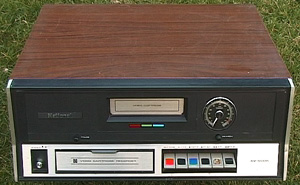Post by LanceM on Jul 7, 2009 3:29:37 GMT
ahh, yes the National series EIAJ Video Cartridge System. Daniel Gosson of New South Wales, Australia has a one of these models, which he displays in great detail on his you-tube account:
www.youtube.com/watch?v=whTyRDBV5DA&fmt=18
Also, cutebikerwanabe on you-tube has two of these machines. His are National NV-5120a units.
www.youtube.com/watch?v=cpmGmMzfkUw&fmt=18
All machines pictured here are PAL standard. Am unsure if National ever did market any NTSC units.The closest NTSC units to my knowledge would probably be the V-Cord series VCR. Such as labguy's "1976 Sanyo VTC-8200 V-Cord I/II Color Dual Speed VCR":
www.labguysworld.com/Sanyo_VTC-8200.htm
Displayed above on his classic video museum site. An amazing resource by the way for anyone interested in researching classic video systems, this is the place to find masses of info on many of the open reel, and some VCR cartridge systems of years gone by.
The Sony CV-2000 1964) series Skip-Field VTR's are considered by most to be the first domestically aimed open reel video product. Of course there were also the Peto Scott/Phillips EL-3400 series machines, which had omega warp recording on 1in tape. The Baird TV recordings from the 30line systems of the 1930's, I would think to be among the earliest enthusiast/inventor recordings that were made. Seeing that the 2in Quadraplex Broadcast machines, such as the first VR-1000:
videopreservation.stanford.edu/dig_mig/images/Ampex_VR_1000-B.JPG
Of course, as well the Vision Electronic Recording Apparatus ( VERA) from the BBC in 1952. Later superseded by the Ampex 2in machines.Would think machines such as the VKR series, were a rarity in their day.And even then from the responses of the contacts through the work of Dick Fiddy, they were not all that impressed by these machines. Let alone, where would they obtain replacement tape stock to make further recordings? As am sure these would have been quite expensive in their own right,possibly owing to the lack of enthusiasm about these.However, who knows, there might as yet be some recordings of this nature lurking about.As these largely resembled the open reel audio tapes of their time, these could be easily mistaken for audio recordings.
Domestic film recordings, as we have seen, are also equally rare off the TV set, and film was much more commonly found than video tape, even then would of thought this to be the case.However, there have been quite a deal of early open reel recordings surfacing of late, so who is to say what may be out there, may never know.
Cheers,Lance.
www.youtube.com/watch?v=whTyRDBV5DA&fmt=18
Also, cutebikerwanabe on you-tube has two of these machines. His are National NV-5120a units.
www.youtube.com/watch?v=cpmGmMzfkUw&fmt=18
All machines pictured here are PAL standard. Am unsure if National ever did market any NTSC units.The closest NTSC units to my knowledge would probably be the V-Cord series VCR. Such as labguy's "1976 Sanyo VTC-8200 V-Cord I/II Color Dual Speed VCR":
www.labguysworld.com/Sanyo_VTC-8200.htm
Displayed above on his classic video museum site. An amazing resource by the way for anyone interested in researching classic video systems, this is the place to find masses of info on many of the open reel, and some VCR cartridge systems of years gone by.
The Sony CV-2000 1964) series Skip-Field VTR's are considered by most to be the first domestically aimed open reel video product. Of course there were also the Peto Scott/Phillips EL-3400 series machines, which had omega warp recording on 1in tape. The Baird TV recordings from the 30line systems of the 1930's, I would think to be among the earliest enthusiast/inventor recordings that were made. Seeing that the 2in Quadraplex Broadcast machines, such as the first VR-1000:
videopreservation.stanford.edu/dig_mig/images/Ampex_VR_1000-B.JPG
Of course, as well the Vision Electronic Recording Apparatus ( VERA) from the BBC in 1952. Later superseded by the Ampex 2in machines.Would think machines such as the VKR series, were a rarity in their day.And even then from the responses of the contacts through the work of Dick Fiddy, they were not all that impressed by these machines. Let alone, where would they obtain replacement tape stock to make further recordings? As am sure these would have been quite expensive in their own right,possibly owing to the lack of enthusiasm about these.However, who knows, there might as yet be some recordings of this nature lurking about.As these largely resembled the open reel audio tapes of their time, these could be easily mistaken for audio recordings.
Domestic film recordings, as we have seen, are also equally rare off the TV set, and film was much more commonly found than video tape, even then would of thought this to be the case.However, there have been quite a deal of early open reel recordings surfacing of late, so who is to say what may be out there, may never know.
Cheers,Lance.


